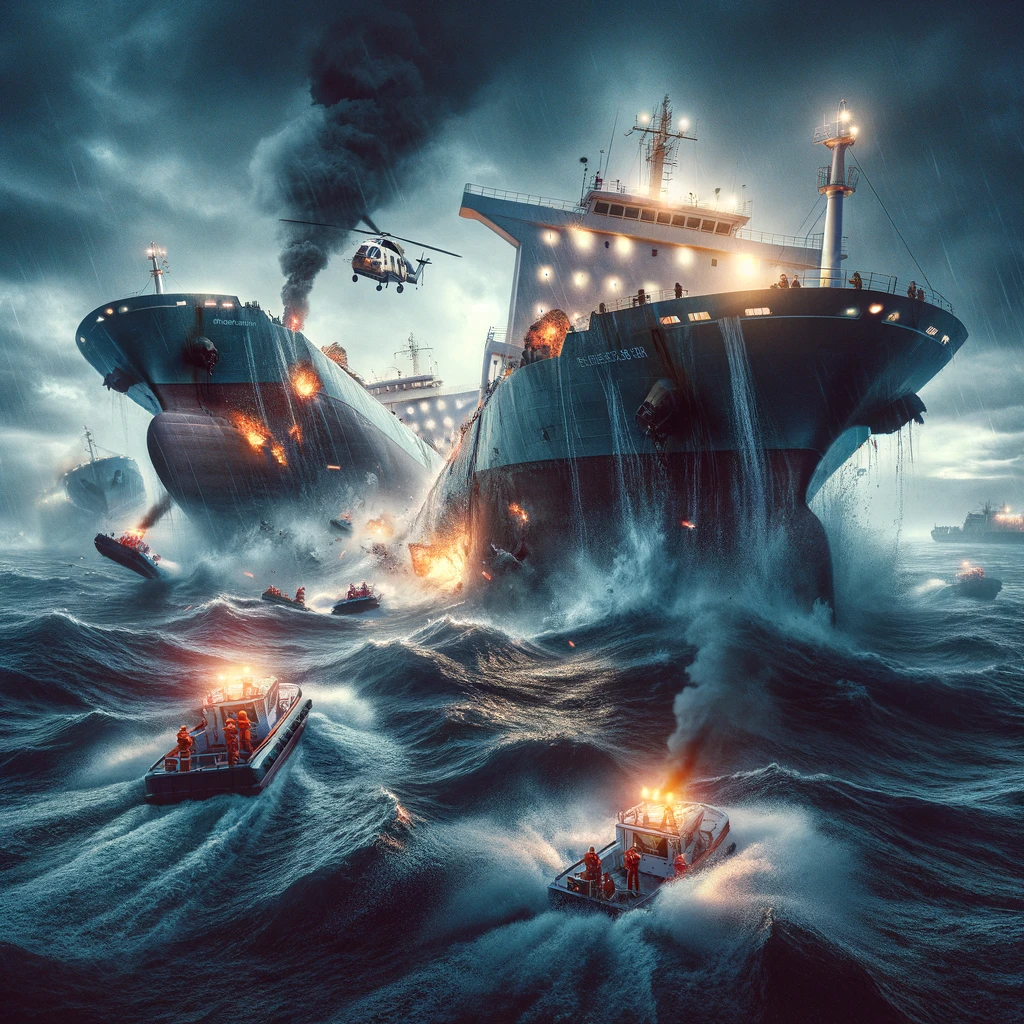Marine accidents, unforeseen and often devastating events, are a stark reality in the world of maritime transport. These unplanned incidents occurring on ships and various marine vessels can unleash a cascade of harmful consequences, ranging from extensive property damage and tragic loss of life to severe environmental pollution that can impact ecosystems and coastal communities for years to come.

The vastness and power of the ocean, coupled with the complex machinery and human element involved in seafaring, create an environment where accidents, though often preventable, can and do occur. Understanding the nature, causes, and impact of marine accidents is crucial for anyone involved in the maritime industry, as well as for the broader public concerned with safety and environmental protection on our oceans.
The Multifaceted Causes of Marine Accidents: A Chain of Unfortunate Events
Marine accidents are rarely the result of a single isolated factor; instead, they typically arise from a complex interplay of contributing causes. These causes can broadly be categorized, though often intertwine in real-world scenarios. Human error consistently ranks as a leading cause, encompassing mistakes in navigation, misjudgment of situations, fatigue-induced lapses in attention, and failures in communication protocols amongst crew members. Mechanical failure represents another significant category, encompassing a wide spectrum of potential issues, from critical engine malfunctions or steering gear breakdowns to failures in essential onboard systems like fire suppression or navigation equipment.
Finally, the sheer power and unpredictability of natural disasters contribute to marine accidents. Severe storms, hurricanes, extreme weather events, and even unusual phenomena like rogue waves can overwhelm even well-equipped and expertly crewed vessels, leading to catastrophic outcomes. It’s crucial to recognize that these categories are not mutually exclusive; for instance, human error might exacerbate the consequences of a mechanical failure, or severe weather might create conditions where even a minor technical issue becomes a major accident trigger.
Common Types of Marine Accidents: A Spectrum of Perils at Sea
The spectrum of marine accidents is diverse, encompassing various types of incidents, each with its own set of characteristic dangers and potential consequences. Collisions, the forceful striking of one ship by another, are a frequent concern, capable of occurring due to a multitude of factors. Poor visibility conditions, such as dense fog or heavy rain, often significantly reduce a mariner’s ability to visually detect other vessels. Navigation errors, including miscalculations of course or misinterpretations of navigational data, can place vessels on intersecting paths. Failures in communication, whether in radio communication between ships or misunderstandings within a vessel’s bridge team, can prevent timely evasive actions.
A collision, depending on the size and speed of the vessels involved, can result in severe structural damage, potentially leading to sinking. Tragically, collisions can cause injuries or fatalities among crew and passengers. Furthermore, collisions often lead to the release of cargo, including environmentally hazardous substances like oil or chemicals, into the marine environment. Groundings, the unintentional running of a vessel aground onto a shoal, reef, coastline, or seabed, pose another significant risk. These incidents can arise from inaccurate or outdated nautical charts that fail to properly depict underwater hazards. Navigation errors, similar to those causing collisions, can lead a vessel into dangerously shallow waters. Unforeseen low tides, especially in areas with significant tidal ranges, can reduce water depth below a vessel’s draft. Groundings can inflict substantial damage on a ship’s hull, potentially causing breaches and flooding. Propellers and rudders, vital for maneuverability, are particularly vulnerable to damage during grounding events.
As with collisions, groundings can cause injuries, fatalities, and the potential for environmentally damaging spills if hull integrity is compromised. Fires breaking out onboard ships are a constant and ever-present danger. These onboard fires can originate from various sources. Electrical faults within the vessel’s complex electrical systems are a common ignition point. Engine malfunctions or overheating machinery in the engine room can also spark fires. Flammable materials carried as cargo or present in the ship’s stores, if improperly handled or stored, can fuel and accelerate fires. Once ignited, shipboard fires can spread with alarming speed, consuming the vessel’s structure, critical equipment, and valuable cargo. The dense smoke and toxic fumes produced by ship fires pose severe respiratory hazards to crew and passengers, and tragically, fires are a major cause of maritime injuries and fatalities.
Sinkings, the ultimate and catastrophic marine accident, represent the complete loss of a vessel as it becomes submerged. Sinkings are often the culmination of a chain of events initiated by other accident types, such as collisions or groundings that compromise hull integrity, or unchecked fires that weaken the vessel’s structure. Flooding, whether due to hull breaches or other causes, can overwhelm a ship’s buoyancy and lead to sinking. Structural failure, where the vessel’s hull or internal framework is weakened beyond its ability to withstand sea stresses, can also result in sudden sinking. The consequences of a sinking are devastating, often resulting in the total loss of the vessel itself and its entire cargo. Sinkings are frequently associated with significant loss of life among crew and passengers. Additionally, sinkings can contribute to long-term water pollution, especially if the vessel contains fuel, oil, or hazardous materials that are released upon submersion and subsequent deterioration of the wreck.
Finally, oil spills, releases of oil into the marine environment from ships, represent a particularly environmentally damaging type of marine accident. Oil spills can be triggered by a range of initiating events, including collisions, groundings, fires, and sinkings that damage a vessel’s fuel tanks or cargo containment systems. Oil spills inflict devastating effects on the marine environment and delicate coastal ecosystems. Wildlife, including seabirds, marine mammals, and fish, are severely impacted through direct contact and ingestion. Coastal communities that rely on fishing or tourism industries suffer significant economic losses due to contaminated waters and damaged shorelines. The long-term ecological consequences of large oil spills can persist for decades, impacting biodiversity and ecosystem health.
Iconic Marine Accidents: Lessons from the Past
History is unfortunately replete with examples of major marine accidents that have shaped safety regulations and highlighted the inherent risks of seafaring. One of the most infamous and tragic marine disasters remains the sinking of the Titanic in 1912. This British passenger liner, widely proclaimed as “unsinkable” at the time, met its end in the frigid waters of the North Atlantic Ocean after colliding with an iceberg. The catastrophic sinking of the Titanic resulted in the loss of over 1,500 lives, a staggering human tragedy that shocked the world. A key contributing factor to the scale of the disaster was the inadequate number of lifeboats onboard the Titanic, insufficient to accommodate all passengers and crew, a direct consequence of then-prevailing, and ultimately flawed, safety regulations. The Titanic disaster has become deeply embedded in popular culture, inspiring countless books, films, and documentaries that continue to explore the human stories and systemic failures that contributed to the tragedy.
More recently, the grounding of the Ever Given container ship in the Suez Canal in 2021 serves as a stark reminder of the potential for even non-fatal marine accidents to have massive global repercussions. The Ever Given, a colossal container ship, ran aground within the narrow confines of the Suez Canal, one of the world’s most critical maritime arteries. This grounding effectively blocked the Suez Canal for six agonizing days, causing a monumental disruption to global shipping and international trade. The economic impact of the Suez Canal blockage was estimated in billions of dollars, as supply chains were severely hampered and goods were delayed worldwide.
Beyond the immediate economic disruption, the Ever Given incident also caused localized environmental damage due to dredging operations undertaken to refloat the massive vessel and the environmental impact of the numerous tugboats involved in the salvage effort. These are but two examples chosen from a vast historical record of marine accidents. The consistent pattern across these incidents is that marine accidents are fundamentally unpredictable and inherently dangerous events, capable of inflicting severe consequences on human lives and the natural world.
Learning from Tragedy – Prevention as the Key to Safer Seas
The history of marine accidents, marked by tragedies like the Titanic and disruptions like the Ever Given grounding, provides invaluable, if somber, lessons. Marine accidents are not simply unfortunate events; they are complex incidents with identifiable causes that can, to a significant degree, be mitigated through proactive measures. It is of paramount importance that the maritime industry, regulatory bodies, and individual mariners consistently learn from past accidents, meticulously analyze their contributing factors, and proactively implement preventative strategies to minimize the likelihood of recurrence.
Continuous advancements in navigational technology, rigorous crew training programs, stringent safety regulations, and a pervasive culture of safety consciousness within the maritime community are all vital components of a comprehensive approach to preventing future marine accidents and ensuring safer and more sustainable practices on our oceans.
